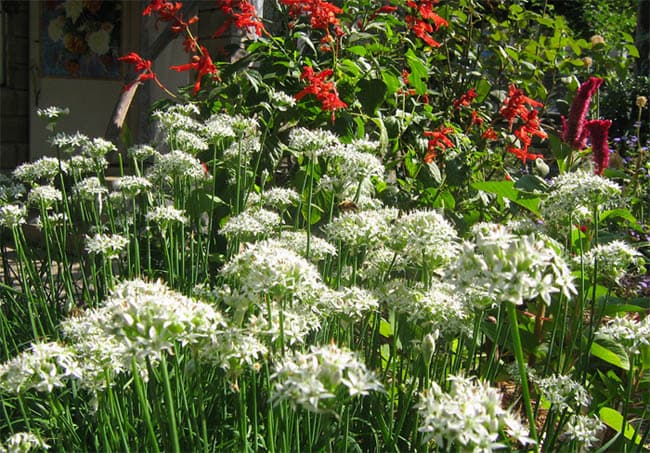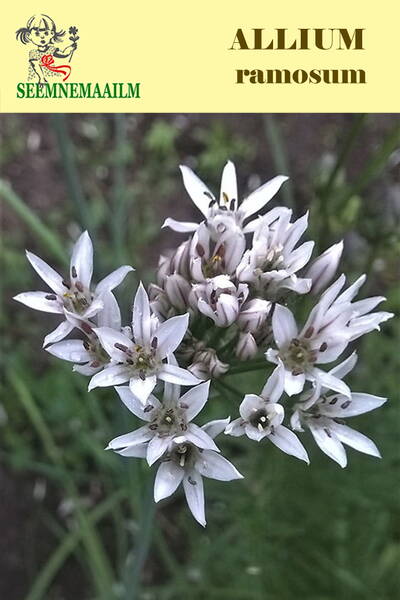Ex Tax: 2.45€
Mild, pleasant scent! The leaves do not grow coarse throughout the summer!
Mid-season (from germination to cutting leaves 30-37 days) variety of perennial rhizomatous onion.
The bulbs are narrow-cylindrical, narrow-conical, weakly expressed. The leaves are flat, 1 cm wide, 17-27 cm long, with a weak garlic flavor and aroma, 30-35 cm long, 0.9-1.1 cm wide.
The inflorescence is an umbrella, located on a high straight peduncle, 30-50 cm high. The flowers are snow-white, very fragrant, with an unusually pleasant aroma of hyacinth.
Contains ascorbic acid, sugars, mineral salts. The content of ascorbic acid is 85-89 mg%, it has a low fiber content, due to which the leaves do not coarsen until late autumn.
It is used fresh for food, as a seasoning for the first and second courses, salads. Fresh herbs of fragrant onions normalize digestion and metabolism, they are recommended for overwork, depression and serious illnesses, for quick recovery of strength and health, and strengthening the body. Excellent honey plant.
The value of this onion: high yield, long period of return of production, high taste qualities of green leaves, winter hardiness.
Cutting greenery begins from the second year, 2-3 times a season.
Productivity at one-time harvesting is 1.3-1.5 kg/m2, with repeated cutting up to 2.7 kg/m2.
Sowing in open ground: April - May.
Harvest: July - August.
Landing pattern: 20x30 cm.

Sweet-Scented Onion, Chinense chives. Bot.syn.: Allium tuberosum, Allium odorum L.
GROWING IN THE GARDEN.
All aspects of green quality depend on crop conditions. For the development of fragrant onion plants, the optimum temperature is + 20 ° C, but it grows normally at lower temperatures in the temperate climate zone.
Allium ramosum (odorum) has adapted well to many types of soil, but on fertile and well-fertilized lands, it adapts better to any climate zone.
In the homeland of this onion, methods of its cultivation have historically developed, which can serve as the basis of agricultural technology in any climatic zone with appropriate adaptation to growing conditions.
In Northern China, it is traditionally grown in a perennial crop of 7 to 30 years. Seeds are sown in spring to a depth of 1 cm, in four grooves. In the first year, the plants are watered only in case of emergency in order to get a developed root system and the leaves are not cut. The following year, in early spring, dead leaves are removed, the plants are planted at the base of the shoots, and the rows in the grooves are sprinkled with a 4-6 cm layer of sandy soil to obtain bleached false stems. After the leaves grow, the rows are thinned out, forming the required distance between plants.
You can also transplant plants from seedling beds to a permanent place. In this case, the seedlings are placed in ribbons of 4 rows; the distance between lines is 35 cm, and between plants in a row is 16 cm.
Starting from the second year, three cuttings of leaves are carried out per season (when the plants reach a height of 20 cm) with an interval of 20-30 days; at the end of summer, cuttings are stopped. In late autumn, the beds are harrowed. To remove old and dead roots, mulch the soil around the plants with a 1-5 cm layer of loose humus. Top dressing is carried out after cutting. Transplanting and dividing the bushes of allspice is carried out in the spring, because in early autumn the plants still bloom and therefore take root worse.
As a rule, Allium odorum does not bloom in the first year after sowing (with the exception of varieties from South Asia, which bloom in the first year after the formation of 5-6 leaves). In the third and subsequent years, four cuts of inflorescences are carried out for bouquets.












